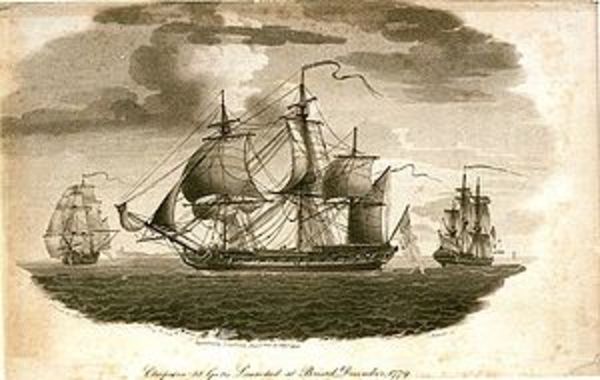
Source: Courtesy of Wikimedia Commons
WINNIETT, Sir WILLIAM ROBERT WOLSELEY, naval officer; b. 2 March 1793 in Annapolis Royal, N.S., third child of Sheriff William Winniett and Mary Totten; great-grandson of William Winniett*; m. 10 Aug. 1828 Augusta Julia Fenwick, daughter of Colonel William Fenwick of the Royal Engineers and god-daughter of the late Edward* Augustus, Duke of Kent, in Woolwich (London), England, and they had three sons and a daughter; d. 4 Dec. 1850 in Accra (Ghana) of “chronic dysentery.”
William Robert Wolseley Winniett probably attended John McNamara’s school at Annapolis Royal, and when he was 14 he entered the Royal Navy as a second class volunteer on the frigate Cleopatra, then at Halifax. The Cleopatra saw action against the French at Guadeloupe and Martinique in 1809, and assisted in the capture of the French frigate Topaze at the former place. On 20 Aug. 1811 Winniett, then a midshipman, was transferred to the Africaine and served for two years in the East Indies, being master’s mate from June 1812 to October 1813. Thereafter he was on various ships in the waters off North America, Europe, and the West Indies until late 1818. On 24 December of that year he was assigned to the Morgiana, then on the African coastal patrol for the suppression of the slave trade. Promoted lieutenant on 29 Jan. 1821, Winniett remained on the African station, and on 17 March 1837 took command of the schooner Viper. The Lightning, which he commanded from 1 Jan. 1843, was one of the first steamers to be used as a warship by the Royal Navy. A commander from 5 Oct. 1843, on 24 Oct. 1845 Winniett became lieutenant governor of the Gold Coast (Ghana).
In 1843 the scattered British settlements of the Gold Coast had been united into a colony, which was placed under the jurisdiction of Sierra Leone. When Winniett arrived at Cape Coast Castle (Ghana) in April 1846 his main concerns were the protection of British traders and the slave trade. To the former end, in April 1847 he made a visit to the kingdom of Dahomey, the most powerful state in west Africa, and induced King Ghezo to sign a treaty of amity and commerce. The lieutenant governor dispatched a further mission to the Dahomeyan capital of Abomey (Benin) in November 1848, but Ghezo refused to abolish the slave trade, which was highly profitable to his kingdom. Winniett was no less energetic on other fronts, and when in 1848 the king of Amanahia, a coastal state, murdered and harassed Europeans and Africans, Winniett persuaded other local rulers to join him in an expedition which captured and imprisoned the king. In September of the same year Winniett travelled to the kingdom of Ashanti, where he attempted to persuade King Kwaku Dua I to abolish human sacrifice. The journey marked the first visit of a British governor to the Ashanti capital of Kumasi (Ghana).
During 1849 Winniett was in England on leave, and on 29 June he was knighted “for important services performed by him in securing friendly treaties with several of the most powerful Sovereigns in Africa.” In further recognition of his efforts, on 24 Jan. 1850 the Gold Coast settlements were made into an independent colony, with Winniett as the first governor. Winniett presided over the transfer of the Danish coastal forts to British control in March 1850, and later that year submitted a comprehensive and optimistic report on the progress of the colony, but he died in December, “sincerely regretted, no less by his countrymen and the [naval] profession at large, than by the tens of thousands of the black population” under his government. He was remembered in Nova Scotia as a successful naval officer and as “a colonist attaining one of the highest positions to which a British subject can aspire – not only that of Lieutenant-Governor, but of Governor-General.”
PRO, ADM 9/16/5732; ADM 196/6: 582. St Luke’s (Anglican) Church (Annapolis Royal, N.S.), Reg. of baptisms, 1782–1817 (mfm. at PANS). Acadian Recorder, 4 Oct. 1828. Novascotian, 25 Feb. 1850, 31 March 1851. W. R. O’Byrne, A naval biographical dictionary: comprising the life and services of every living officer in her majesty’s navy . . . (London, 1849), 1310. W. A. Calnek, History of the county of Annapolis, including old Port Royal and Acadia . . . , ed. A. W. Savary (Toronto, 1897; repr. Belleville, Ont., 1972). W. W. Claridge, A history of the Gold Coast and Ashanti . . . (2nd ed., 2v., London, 1964). G. W. Hill, Nova Scotia and Nova Scotians . . . (Halifax, 1858), 27–28. Christopher Lloyd, The navy and the slave trade: the suppression of the African slave trade in the nineteenth century (London, 1968). A. W. Savary, Supplement to the “History of the county of Annapolis” . . . (Toronto, 1913; repr. Belleville, 1973). D. C. Harvey, “Nova Scotia and the Canadian naval tradition,” CHR, 23 (1942): 247–59.
Cite This Article
Phyllis R. Blakeley, “WINNIETT, Sir WILLIAM ROBERT WOLSELEY,” in Dictionary of Canadian Biography, vol. 7, University of Toronto/Université Laval, 2003–, accessed December 12, 2025, https://www.biographi.ca/en/bio/winniett_william_robert_wolseley_7E.html.
The citation above shows the format for footnotes and endnotes according to the Chicago manual of style (16th edition). Information to be used in other citation formats:
| Permalink: | https://www.biographi.ca/en/bio/winniett_william_robert_wolseley_7E.html |
| Author of Article: | Phyllis R. Blakeley |
| Title of Article: | WINNIETT, Sir WILLIAM ROBERT WOLSELEY |
| Publication Name: | Dictionary of Canadian Biography, vol. 7 |
| Publisher: | University of Toronto/Université Laval |
| Year of publication: | 1988 |
| Year of revision: | 1988 |
| Access Date: | December 12, 2025 |



